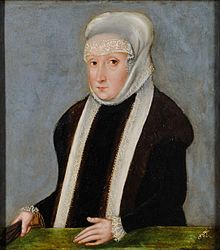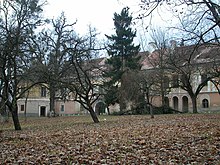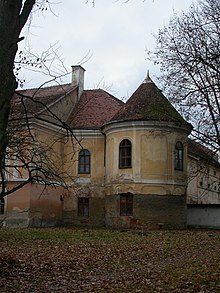Gilau Castle
Gilău Castle (also Gyalu ) is a former aristocratic seat in the municipality of Gilău , Cluj County in the Romanian region of Transylvania . The castle dates back to the end of the 13th and beginning of the 14th century.
history
The castle was built around 1300 as the seat of the Bishop of Transylvania . The earliest documented mention dates back to 1428. During the 1480s, the originally Romanesque building was converted in the early Renaissance style . Only fragments remain from this reconstruction phase.

After the conquest of Buda by the Ottomans in 1541, Gilău Castle became the residence of Queen Isabella Jagiellonica (1519–1559), wife of the Hungarian King Johann Zápolya (1487–1540), who had died the year before, and regent of their underage son Johann Sigismund Zápolya (1540-1571). On this occasion, the castle was rebuilt again, the renovation work was completed in 1543, as evidenced by an inscription in the north-west tower.
In 1633 the castle was acquired by Georg I. Rákóczi (1593–1648), Prince of Transylvania since 1630, under whom it was given its present form through an extensive renovation program. Among other things, he imported decorative tiles from Istanbul for the redesign , with which he had the later famous tiled room decorated. After the death of his son and successor Georg II. Rákóczi (1621–1660, Prince of Transylvania since 1648), the property was given to Baron Dennis Banffy de Losoncz in 1663, and it remained in his family until the end of the Second World War . The castle was destroyed by fire in 1707 and was no longer inhabited by the family for the next 120 years.
In 1838 Count Dennis Banffy restored the building. The old vaults on the ground floor were largely preserved. The former moat was filled in and the castle was instead surrounded by an English landscape garden. In 1861 the property was hit by another fire. After the death of Count Dennis Banffy, a relative inherited the castle, who sold it to a businessman in 1877. The new owner repaired the damage caused by the last fire. The second floor was removed and replaced by a large gable roof. In 1911, Katherine Barcsay de Nagybarcsa, a née Countess Banffy de Losoncz, acquired the castle, which returned to the previous owners. Katherine and her husband Thomas restored and modernized the building. After the death of Thomas Barcsay it was managed by Joseph Barcsay, their son, who together with his wife Eva Barcsay had the interior of the castle renovated in the 1940s.
At the end of the Second World War, the castle was looted and then expropriated. From the late 1940s to the 1980s, it served various government agencies and public institutions. After the Romanian Revolution of 1989 , it was reclaimed from Thomas Barcsay, heir and grandson of Katherine Barcsay, under the Romanian restitution laws.
Architecture and monument protection
The Gilău Castle is now a two-storey building with a total of around 60 rooms. Of these, an approximately 200 square meter, column-decorated dining room on the ground floor and an approximately 250 square meter hall on the upper floor represent the largest and most representative rooms. The total of four wings of the building form an approximately square with a side length of around 70 meters. The sides of the building are roughly oriented in the four cardinal directions. Three of the corners are provided with round towers of different dimensions, while on the southwest corner there is a tower with a hexagonal floor plan.
The castle is surrounded by a 17 hectare landscaped garden. In this park you can find the ruins of the former Roman auxiliary troop camp, Fort Gilău, west of the castle.
The facility is protected as a historical monument under Law No. 422/2001, passed in 2001, and is included in the National List of Historical Monuments (Lista Monumentelor Istorice). Responsible is the Ministry of Culture and National Heritage (Ministerul Culturii și Patrimoniului Na ,ional) , in particular the General Directorate for National Cultural Heritage, the Department of Fine Arts and the National Commission for Historical Monuments and other institutions subordinate to the Ministry. Unauthorized excavations and the export of ancient objects are prohibited in Romania.
literature
- George Dan Dacin: Reabilitarea structurală a monumentului istoric. Castelul din Gilau. / The Rehabilitation of the historic load-bearing structures Castle of Gilău . Sebeș 2015, pp. 273-280, ( digitized version ).
- Adriana Isac, Erwin Gáll and Szilárd Gál: A 12th Century Cemetery Fragment from Gilău (Cluj County) (Germ .: Julmarkt; Hung .: Gyalu) . Ephemeris Napocensis XXII (2012), pp. 301-311, ( digitized version ).
Web links
- Castrul alei Siliana şi vicus-ul militar de la Gilău - parcul castelului Rackoczi on the website of the Institutul Național al Patrimoniului, CIMEC (Romanian, partly in English), accessed on February 27, 2019.
- Gilău Castle from a website of the heir of the former owner, Thomas Barcsay, a retired professor at Ryerson University in Toronto, Canada (English), accessed on February 27, 2019.
- Castelul Banffy Barcsay Gilău , video on youtube (Romanian), accessed on February 27, 2019.
- Castelul din Gilău, Cluj , video on youtube (Romanian), accessed on February 27, 2019.
- Castelul Banffy din Gilău va fi renovat , news from TVR Cluj on youtube (Romanian), accessed on February 27, 2019.
Individual evidence
- ↑ Gilau Castle - History on a website of the heirs of the former owners (English), accessed on February 27, 2019.
- ↑ Gilau Castle - About on a website of the heirs of the former owners (English), accessed on February 27, 2019.
- ↑ List of historical monuments on the website of the Romanian Ministry of Culture and National Heritage
Coordinates: 46 ° 45 ′ 24 " N , 23 ° 22 ′ 56.7" E

